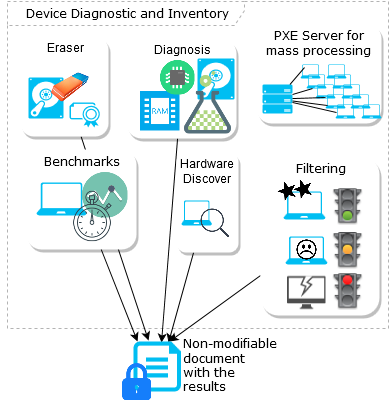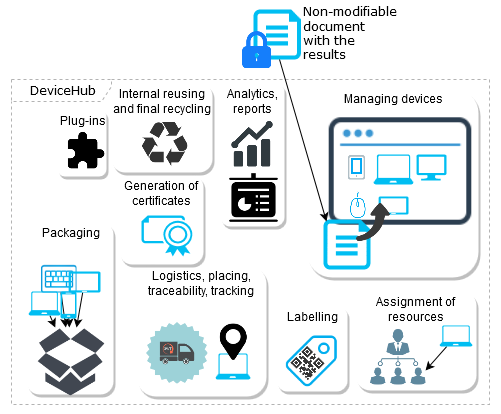Incorporated in 2015, eReuse.org has spent about a decade promoting best practices for data sanitization and traceability through the digitalization of the circular economy of digital devices, working with organizations across the globe. For the implementation of these best practices and standards, eReuse.org proposes an open-source stack for ITADs, Refurbishers, and recyclers.
The software is developed and maintained by the respective organizations, and you will find it in their repositories.
- The Workbench creates a hardware snapshot of the device and its components, including a digital unique global ID. If the device is a computer, Workbench performs tests and benchmarks on components and erases hard drives, including these results in the report.
- Workbench can upload reports to Devicehub. Devicehub is a device inventory service, also known as IT Asset Management System (ITAMS), focused on maximizing the lifetime of devices and reusing them. It is offered as a cloud service for organizations to manage, track, and exchange their devices.
- The Global Registry of Devices (GRD) receives optional non-private metadata about devices from ITAMS like Devicehub instances. It is an auditable (and replicable) semi-public online log that maintains a global list of traceability information about devices, as simple digital product passports, so it can assist when there is leakage or similar problems, and it can generate inputs for the indicators which measure circularity.
In the following sections, we detail the two main software elements.
Workbench

The Workbench is a toolset that assists in registering, refurbishing, and tracking devices. It captures hardware characteristics (like the serial number) of devices and their components, rates the devices and securely deletes data. With its self-booting start-up, you don’t have to worry about which operating system is installed. Just boot your device through the network with the PXE Server and test and benchmark your system hardware, capture characteristics for rating and the serial number for traceability and reporting. It processes detailed hardware information at the component level. This result is then uploaded to the distributed cloud software; the Devicehub, which we explain next.
The software executes on a computer and, without human interaction, automatically executes the following tools:
- Hardware discovery. Obtains metadata from the computer and its components, including ways of identifying a device and information for traceability, reusing, and generating circularity inputs.
- Data erasure. Deletes private information from data storage units by performing standardized erasure methods that users can parametrize.
- Benchmarking. Rates the capacity of the computer and its components in order to value them.
- Testing. Performs quality tests to guarantee the capacity of the machine to operate correctly and without failure.
See Workbench Computer in Github Download Workbench Live (ISO file)
DeviceHub
 An inventory service or Device Asset Management System, offered as a web app and focused on efficiently managing the circular life-cycle of devices –reusing and recycling. The main objectives are:
An inventory service or Device Asset Management System, offered as a web app and focused on efficiently managing the circular life-cycle of devices –reusing and recycling. The main objectives are:
- To offer a common IT Asset Management system for donors, receivers, and IT professionals so they can manage devices and exchange them. This is reusing—and ultimately recycling.
- To automatically recollect, analyse, process, and share (controlling privacy) metadata about devices with other tools of the eReuse ecosystem to guarantee traceability and provide inputs for the indicators that measure circularity.
DeviceHub recollects devices from the reports of the Workbench and other integrated systems and manages their full workflow and logistics. It manages and prints certificates and customer-friendly reports, places and packaging, and has a plug-in system. Devicehub manages and prints certificates and customer-friendly reports, it manages lots of devices, and it can design and print smart tags with QR data carriers that boost efficiently and avoid leakage. Devices are registered using Workbench. Devicehub can be federated and autonomous (one instance per organization) and interact with external systems (like other Devicehubs) to manage the different processes involved in reusing and recycling, like disposal or external reusing. The main characteristics of Devicehub are:
- Device management: Devicehub manages the asset identification process and the life span of the organization’s devices, the workflow, and external ones over which the organization has control.
- Reports: This feature generates automatic personalized reports and analytics, ensuring compliance and detecting critical aspects, such as device loss, device and ID duplication, etc. Reports can be PDF documents or spreadsheets.
- Certifications: Saves, manages, and exports certificates, such as the test results and hard drive deletions, to answer audits and show them to end users.
- Logistics, traceability, and tracking: manages the transportation of devices by mapping their coordinates to places and assigning transporters and destinations.
- Compliance management: This involves setting compliance rules for many devices and reacting when irregularities occur or when they break. Compliance can be shared between Devicehubs.
- Device rate and selling price: rates devices according to the benchmarking and testing reports of Workbench, taking into account performance, functionality, and aesthetics. Finally, it suggests a parametrizable range of prices.

The Global Registry of Devices (GRD) (Experimental, under development)
The Global Registry of Devices (GRD) is an auditable online log that maintains a global list of traceability information about devices, so it can assist when there is leakage or similar problems. The GRD works with open data and is designed to be used with external users who want to report traceability information. At the same time, GRD aggregates traceability data with the objective of using this data as inputs for indicators measuring circularity indicators. It is comparable to a distributed blockchain. GRD provides a REST API to allow ITAMS, such as DeviceHub instances, to report the life cycle of devices, environmental responsibilities for organizations, etc. It collects from each device along lifespan.
Legacy
Workbench Android App
A smartphone and tablet Android app that has two functionalities.
- Obtain metadata from devices that are not computers, like peripherals or electrical appliances, by scanning their barcodes and taking pictures from them.
- Link devices with tags generated by the tools, like QR codes and NFC chips.
Download Workbench Android App
Photobox
A machine that assists in rating the appearance of a device by taking pictures from devices from different views, like frontal, sides and rear. A developing AI can detect scratches and imperfections from the pictures and automatically rate the devices.